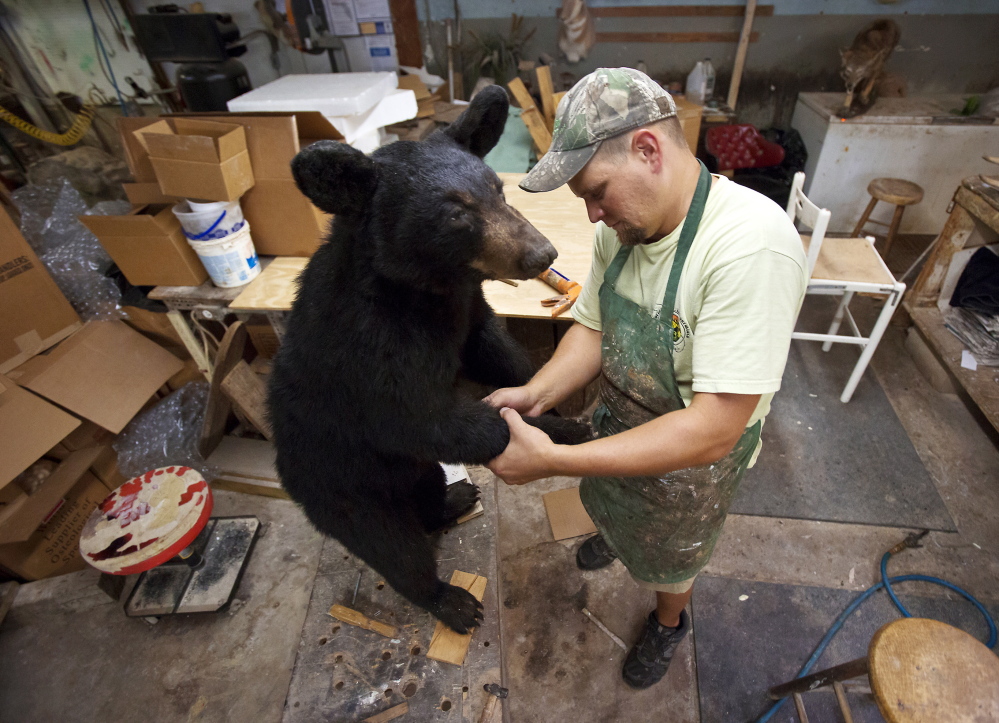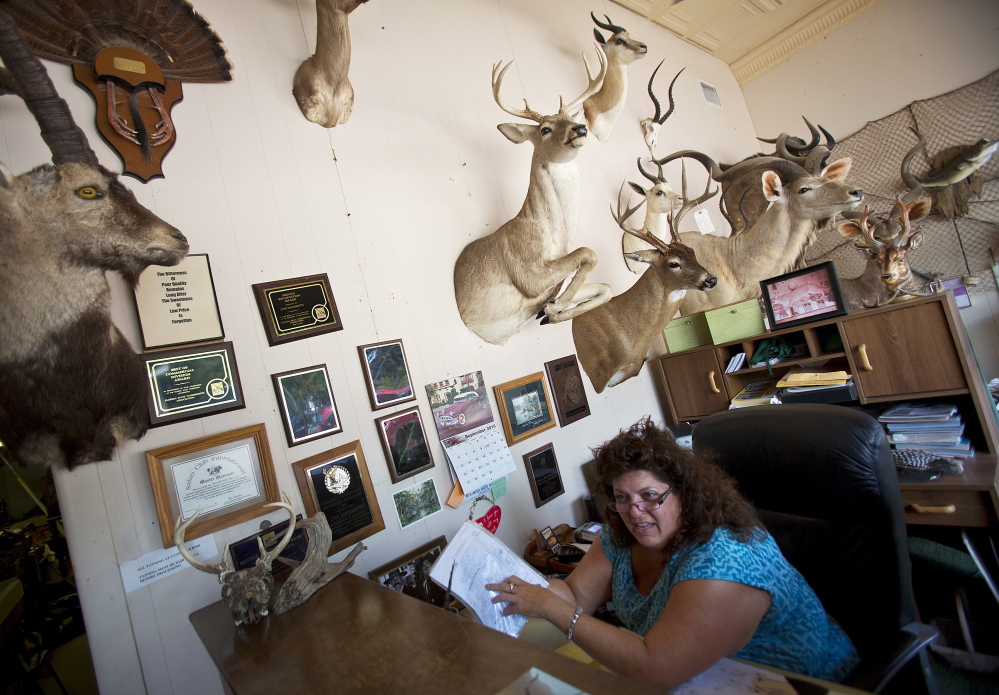Death and taxidermy
OCOEE, Fla. — The workshop at Master Taxidermy Studio looks like a cross between an antique tool shop and a medieval torture chamber.
The windowless room, with antlers and driftwood hanging from the high ceiling, teems with clamps, drills, saws, scalpels, screwdrivers, scissors and tools handmade by co-owner Derrick Powell and his granddad.
One is a spoon with a bent handle that Powell uses to remove eyeballs. He replaces them with glass versions.
Watching Powell use the spoon and some of his sharper equipment is not for the faint of heart. But for him and partner Sherri Brady, it beats working for someone else.
“I have a passion for it,” said Powell, 28, whose nickname is “Ducky.” “It’s what I like to do.”
Business at the studio is picking up with the Florida alligator-hunting and South Carolina deer-hunting seasons in full swing, said Brady, 51, Powell’s mother-in-law.
Florida’s first bear hunt in 21 years, coming up in October, also is expected to bring in customers, she said.
The studio, nestled between a hair-and-nail salon and an antiques store in downtown Ocoee, was opened in 1972 by Powell’s grandparents, John and Judy Bartoletti. They retired five years ago.
The reception room is a hodgepodge of deer and antelope heads, wild-turkey trophies, a white-wolf rug, armadillo baskets, a roadkill coyote and an elephant-ear table shaped like Africa that has zebra feet.
One paneled wall near the entrance bears dozens of pictures of hunters posing with their fish and game, reminiscent of Cecil the African lion and the Minnesota dentist who caused international outrage when he killed the animal July 1.
Hunting advocates, including Brady, bristle at the reaction, saying critics don’t understand the sport protects wildlife and habitat and feeds families.
“Just like you have trophies because you’re an excellent football player, they have trophies because you’re an excellent hunter,” she said.
Hunting is big business in Florida. The annual economic impact in the state is $1.6 billion, according to state officials. Recreational freshwater fishing brings in another $1.7 billion, and recreational saltwater fishing is worth $7.6 billion.
“The majority of taxidermists are some of the biggest animal lovers in the world,” said Trina Pritchard, president of the Florida State Taxidermists Association. “I can harvest a turkey for food, and I can put it back together. I can look at it forever and it’s beautiful. It’s art.”
Last week, Powell worked on the pelt of a nuisance black bear that had been euthanized.
He posed the bear on its hind legs, then wrapped his arms around the animal’s waist and gave it a squeeze that looked like the Heimlich maneuver. Next he shaped its empty right eye socket with a small knife, fluffed its fur with an air hose and smoothed its coat with his palms.
A good taxidermist is part tailor, part artist, part craftsman – and all patience.
Powell has a backlog of deer heads, safari specimens and other animals in the freezer, but he can work only so fast. It can take six months, including tanning, to complete one display, although actual work time ranges from six to 30 hours, depending on the animal.
Master Taxidermy’s clients include weekend sportsmen, big-game hunters and education centers.
Greg Walker, a customer for two decades, said hunters typically make trophies of animals that have special meaning, whether it’s a first deer or the biggest fish.
“They make it look like it was when you brought it to them,” said Walker, who has had ducks, largemouth bass, white-tail deer and wild turkeys mounted at the studio.
Powell has preserved lynx, muskrats, beavers, wart hogs, boar, buffalo, pheasants, snow geese, egrets, otters, raccoons and rattlesnakes. The owner of two rescue dogs, Marley and Turbo, he does not stuff pets, partly because it’s difficult to re-create their expressions enough to satisfy families.
The fine work of sewing, molding and grooming begins after the flesh is removed with a wire wheel and the hides are cleaned with a pressure washer, dried and glued to a polyurethane-foam form that can be posed in a wide range of positions.
Powell learned his skills from his grandfather starting when he was 13 – no formal training is required – but he grew up hunting, fishing and cleaning game before he was old enough to go to school. The head of a kudu, an African antelope he shot on a safari, won a blue ribbon in a taxidermy contest and is mounted in the studio, the peach color and black spots in its ears painstakingly restored.
“I like the art of creating something, taking it and making it look alive again,” Powell said, who lives in Clermont.
Prices vary. Brady did not want to be specific for competitive reasons, but a black bear can cost more than $3,000 and a lion more than $5,000. Turkeys, which have freeze-dried, hand-painted heads, ducks and shoulder-mounted deer run in the hundreds of dollars.
The shop also makes accessories such as bearskin rugs and zebra pillows and does original-skin and reproduction fish mounts.
“We try to do something tasteful,” said Brady, a former time-share-resort marketing director who handles the administrative work and customer relations. “It’s one thing if it’s in a man cave. It’s another if they want it in the main part of the house.”
Copy the Story LinkSend questions/comments to the editors.




Success. Please wait for the page to reload. If the page does not reload within 5 seconds, please refresh the page.
Enter your email and password to access comments.
Hi, to comment on stories you must . This profile is in addition to your subscription and website login.
Already have a commenting profile? .
Invalid username/password.
Please check your email to confirm and complete your registration.
Only subscribers are eligible to post comments. Please subscribe or login first for digital access. Here’s why.
Use the form below to reset your password. When you've submitted your account email, we will send an email with a reset code.